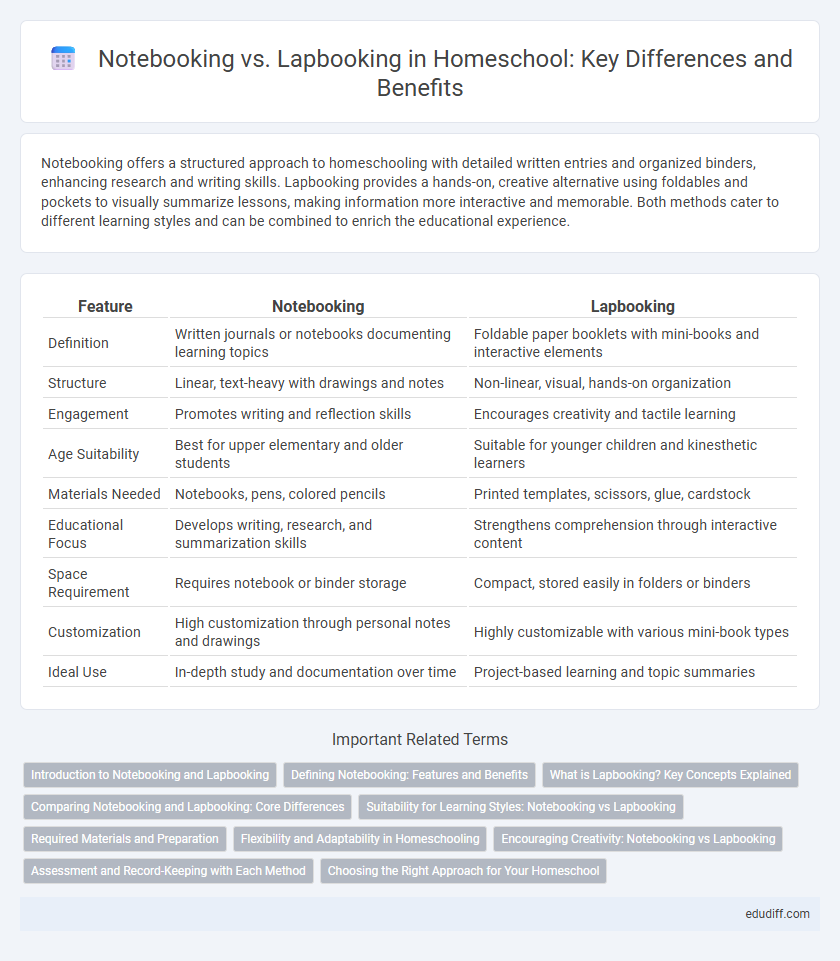Notebooking offers a structured approach to homeschooling with detailed written entries and organized binders, enhancing research and writing skills. Lapbooking provides a hands-on, creative alternative using foldables and pockets to visually summarize lessons, making information more interactive and memorable. Both methods cater to different learning styles and can be combined to enrich the educational experience.
Table of Comparison
| Feature | Notebooking | Lapbooking |
|---|---|---|
| Definition | Written journals or notebooks documenting learning topics | Foldable paper booklets with mini-books and interactive elements |
| Structure | Linear, text-heavy with drawings and notes | Non-linear, visual, hands-on organization |
| Engagement | Promotes writing and reflection skills | Encourages creativity and tactile learning |
| Age Suitability | Best for upper elementary and older students | Suitable for younger children and kinesthetic learners |
| Materials Needed | Notebooks, pens, colored pencils | Printed templates, scissors, glue, cardstock |
| Educational Focus | Develops writing, research, and summarization skills | Strengthens comprehension through interactive content |
| Space Requirement | Requires notebook or binder storage | Compact, stored easily in folders or binders |
| Customization | High customization through personal notes and drawings | Highly customizable with various mini-book types |
| Ideal Use | In-depth study and documentation over time | Project-based learning and topic summaries |
Introduction to Notebooking and Lapbooking
Notebooking and lapbooking are dynamic educational tools in homeschooling that enhance children's learning through creativity and organization. Notebooking involves compiling written notes, drawings, and reflections in a personalized journal, fostering deep understanding and retention of subjects. Lapbooking uses folded, interactive mini-books and manipulatives to explore topics visually and kinesthetically, making it ideal for hands-on learners.
Defining Notebooking: Features and Benefits
Notebooking in homeschooling involves students creating personalized journals or notebooks to document their learning through writing, drawing, and organizing information. This method enhances retention by encouraging active engagement, creativity, and critical thinking, making it ideal for subjects requiring detailed notes and reflections. Benefits include fostering independence, providing a customizable learning record, and supporting diverse learning styles with flexibility in content and format.
What is Lapbooking? Key Concepts Explained
Lapbooking is an interactive homeschooling method where students create personalized folders with mini-books, flaps, and foldables to visually organize information on a specific topic. This hands-on approach enhances retention by combining writing, drawing, and discovery, making learning engaging and creative. Unlike traditional notebooking, lapbooking emphasizes compact, thematic displays that are easy to review and share.
Comparing Notebooking and Lapbooking: Core Differences
Notebooking emphasizes detailed written reflections and personalized learning through organized journals, promoting deep comprehension and creativity in homeschool settings. Lapbooking offers interactive, hands-on learning by incorporating mini-books and foldables within a compact folder, enhancing engagement and visual learning. These methods differ in format and learning style, with notebooking favoring extensive documentation and lapbooking prioritizing tactile, thematic presentations.
Suitability for Learning Styles: Notebooking vs Lapbooking
Notebooking suits learners who benefit from structured written expression and detailed note-taking, facilitating deep reflection and organized content retention. Lapbooking appeals to kinesthetic and visual learners by integrating hands-on activities and interactive foldables that enhance engagement and memory through creative assembly. Selecting between notebooking and lapbooking depends on individual learning preferences, with notebooking favoring analytical processing and lapbooking supporting tactile and visual stimulation.
Required Materials and Preparation
Notebooking requires basic materials such as blank or lined notebooks, colored pens, and stickers to create personalized entries, with preparation focused on organizing content and prompts. Lapbooking involves collecting pre-made templates, folders, scissors, and glue to assemble interactive mini-books, requiring more hands-on preparation to design and print components. Both methods benefit from a quiet workspace and organized storage for materials to enhance the homeschooling experience.
Flexibility and Adaptability in Homeschooling
Notebooking offers greater flexibility in homeschooling by allowing students to creatively record and organize information in personalized ways, adapting to individual learning styles and paces. Lapbooking provides hands-on adaptability, enabling learners to manipulate and rearrange mini-books or foldables, which enhances kinesthetic engagement and accommodates various subjects. Both methods support customizable learning experiences, making them effective tools for tailoring education to each student's unique needs and preferences.
Encouraging Creativity: Notebooking vs Lapbooking
Notebooking encourages creativity by allowing students to personalize their learning with detailed written reflections, drawings, and diagrams, fostering deeper engagement with the subject matter. Lapbooking offers a hands-on, interactive experience through foldable templates and mini-books, which stimulate tactile creativity and make complex concepts visually accessible. Both methods support creative expression but cater to different learning styles--notebooking emphasizes narrative and organization, while lapbooking highlights visual and kinesthetic involvement.
Assessment and Record-Keeping with Each Method
Notebooking offers detailed, individualized assessment through written explanations and creative responses, allowing parents to track student progress over time with comprehensive records. Lapbooking provides a more visual and interactive assessment method, often capturing understanding via foldable mini-books and graphic organizers that showcase key concepts. Both methods facilitate record-keeping, but notebooking typically yields more extensive documentation suitable for formal evaluation and portfolio review in homeschool settings.
Choosing the Right Approach for Your Homeschool
Notebooking offers a structured way for students to document learning through written summaries and creative illustrations, enhancing retention and individualized expression. Lapbooking provides a tactile, visually engaging method by combining mini-books and foldables, ideal for hands-on learners who benefit from interactive study aids. Selecting between notebooking and lapbooking depends on your child's learning style, subject matter, and desired level of creativity to optimize homeschooling effectiveness.
notebooking vs lapbooking Infographic

 edudiff.com
edudiff.com